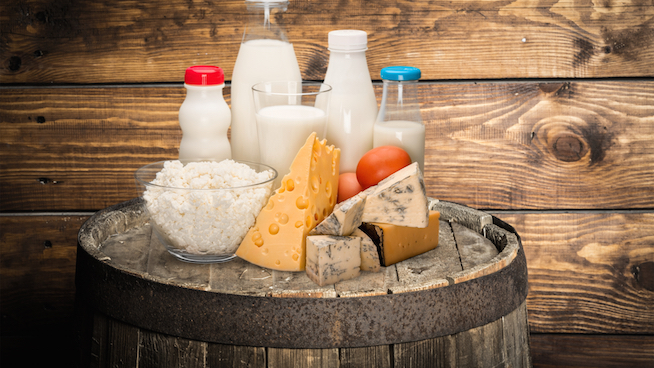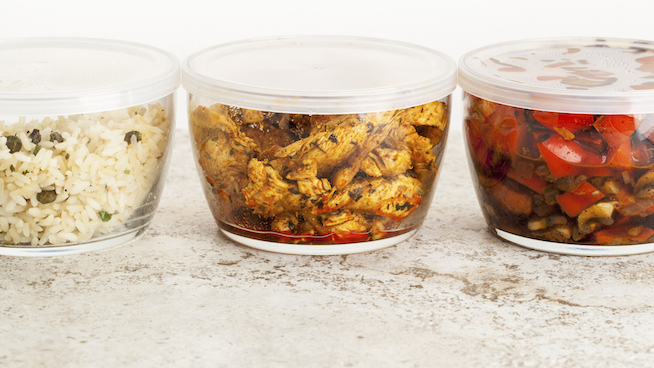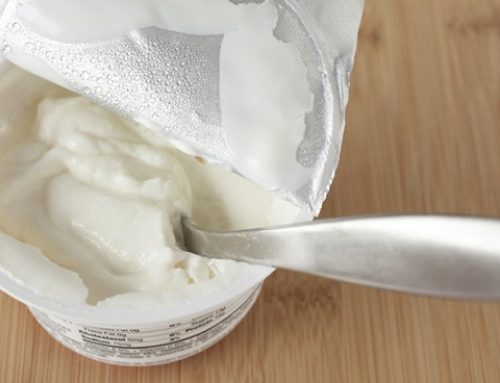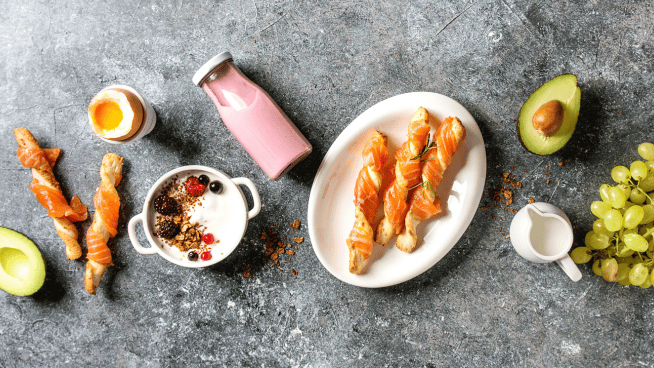Carb Backloading: A Nutrition Hack for Supercharged Performance
Everything you think you know about nutrition may be precisely what’s holding you back from achieving your goals. Carb backloading, a dietary strategy in which you reserve your carbohydrate consumption until late in the day, is yielding unbelievable results for athletes and recreational gym-goers alike. Are you ready to defy conventional wisdom and try it?
The Way Carbs Work
To understand carb backloading, you have to know how carbs affect your body. When you eat carbohydrates, they break down into glucose, or blood sugar. As your blood sugar level rises, your body releases the hormone insulin to bring it back down and maintain balance. Insulin accomplishes this by transporting the carbs (as well as protein and fat, if you’re consuming them at the same time) into your muscle or fat cells. The kind of tissue they end up in depends on many factors, but primarily on how active you have been and what your recovery needs are. Just had a hard workout or a tough game? Insulin will likely drag the carbs you eat into your muscles. In contrast, if you’ve been lying on the couch watching TV, insulin will send the carbs into your fat cells.
Since most of us, regardless of activity level, spend more time at rest than we do engaging in strenuous activity, it makes sense to keep our carb consumption low most of the time, thus minimizing insulin’s potential to stuff our fat cells. But there are times, particularly after workouts or games, when we can benefit from eating enormous amounts of carbohydrate—particularly the kinds that we’ve been warned to avoid by nutritionists (or our mothers).
Turning the (Time) Tables
Many nutritionists recommend consuming the majority of your carbs in the early part of the day and tapering your intake in the afternoon and evening. The thinking here is that your energy needs decline the closer you get to bed, and that your body’s sensitivity to insulin decreases over the course of the day. Insulin sensitivity refers to your cells’ ability to handle the insulin that’s trying to make a delivery of carbohydrate. Upon waking after a long period of fasting (the time you spent asleep), your muscles are ready to soak up carbs and, so the theory goes, carbs you eat at breakfast will be stored in muscle instead of your belly.
The problem with this approach is that cortisol, a stress hormone that steadily rises during the night and peaks around 7 a.m., counteracts insulin and promotes fat gain when carbs are consumed around this time. By backloading your carbs—i.e., eating them later in the day—you wait out the effects of cortisol. Add strength training or an intense sports performance to the mix, and you heighten insulin sensitivity later in the day, allowing you to eat a significant amount of carbs that go directly to your muscles.
Avoiding carbs during the day offers significant health and performance advantages as well. With nothing to encourage insulin release, you’ll burn fat all day long, and higher-than-normal amounts during a practice, game or workout. A lack of carbs in your system also fires up the sympathetic nervous system—your “fight or flight” response—which means sharper, clearer thinking and natural energy. You won’t “crash” in the afternoon.
The Carb Backloading Schedule
This is the basic protocol for carb backloading, as prescribed by its creator, John Kiefer, a physicist-turned-nutritionist who has worked with many elite athletes. (Visit him at dangerouslyhardcore.com.)
1. For 10 days straight, keep your carb intake under 30 grams per day.
It’s not fun, but it’s necessary to recalibrate your body to process carbs more effectively. You may feel sluggish for the first few days, so coffee with heavy cream (no sugar or milk—they’re carbs) or sugar-free energy drinks are permissible to keep you going. Stick it out. You’ll lose fat during this time and heighten your muscles’ ability to store carbs in your muscle cells.
You must cut out carbs in all their forms except fiber. Green vegetables are okay, but grains, fruit, root vegetables (such as potatoes) and even nuts have to be severely limited. Anything that isn’t fiber counts toward your 30-gram allowance, so be careful.
The only other dietary restriction is to abstain from alcohol. Eat plenty of protein—at least one gram per pound of your body weight daily. (If you weigh 150 pounds, aim for 150 grams of protein.) Fat is also a must on this plan. Bacon, whole eggs, red meat and cheese are perfectly good choices. Before you yell “heart disease” and list the supposed dangers of saturated fat, consider the research. An August 2010 study published in the Annals of Internal Medicine affirmed earlier findings that a low-carb diet that includes saturated fats actually reduces risk factors for heart disease. A 2007 study at the University of Connecticut found that low-carb dieters who consumed more than three times the amount of saturated fats as did subjects in a low-fat group saw a greater improvement in their LDL cholesterol levels.
In other words, don’t fear fat. To prevent muscle loss and keep yourself from feeling starved, eat fat regularly along with protein. You don’t have to count calories either. Just cut carbs.
2. On the evening of the 10th day, carb up.
The best way to break your carb fast is to perform a strength workout or other intense activity (wrestling practice or a basketball game would be good) in the afternoon or evening just before eating. Then begin splurging. That’s exactly what it sounds like. Eat hearty, making sure to consume a meal rich in both protein and carbs (ancillary fat is okay, too). Your body won’t be able to store carbs for body fat at this point because it’s been depleted. Aim for about one gram of carbs for every pound of your body weight, although you may be able to get away with significantly more. Don’t worry, just eat.
The best sources of carbs at this time are not brown rice and oatmeal, as you may have been taught. Higher-glycemic, insulin-spiking carbs are not only preferred, they are necessary. The point is to open up your muscle cells and jam carbs back into them to build muscle mass and provide energy for future workouts; and nothing does that like sugary and starchy foods. White rice, sweet potatoes and ripe bananas are ideal, but you can also reward yourself with junk food like pastries, ice cream and candy. An evening backload might consist of a hamburger with french fries, a milkshake, cherry turnovers, and a protein shake mixed with bananas or a carb powder supplement before bed. A big sushi dinner followed by a frozen yogurt would also be effective.
3. Evaluate yourself the next morning in the mirror.
More than likely, you’ll look as lean as you did the morning before, and your energy will be high. However, if you feel bloated and slow with a big belly to match, you overdid it a bit. Note that you will not have gained fat, but your body will be temporarily saturated with carbohydrates and the extra water they carry. It will take time for the bloating to reduce. The effects of backloading are individual and can only be adjusted with trial and error.
4. Going forward, backload your carbs in this manner on days you train or play.
On days you do not work out, stick with the low-carb plan you followed for the first 10 days (there are exceptions to this, however—see “Carb Backloading for Athletes,” below). Although backloading works best when exercise takes place between roughly 4 p.m. and 6 p.m., you can tweak this approach if your schedule requires you to work out in the morning.
If you have a workout or practice at 7 a.m., plan to wake up between 5 and 6 a.m. Have some black coffee but no food. After your activity, have a small meal or shake containing fast-digesting carbs. Again, a protein shake and banana are perfect. Chicken and white rice are fine if you want to go the whole food route. Shoot for about 30 to 40 grams of protein and the same amount of carbs. Keep fat to a minimum.
From that point until around 6 p.m., eat low-carb. Then backload, but be more conservative. Since you’re several hours removed from your workout, your muscles aren’t as sensitive to insulin’s effects, so you’ll have to eat fewer carbs than you would if you had just trained.
Carb Backloading for Athletes
Gorging on carbs doesn’t always have to take place after strenuous exercise. You can time your backloading nights to peak your performance for competition. If you play field hockey, soccer, basketball or another sport that requires long-duration activity, one that tests your endurance more than your power and speed, you can backload a day or more before games to get an edge.
If the contest is on Saturday, start going low-carb two Wednesdays beforehand. Stick with low-carb eating for seven full days—until the Thursday before game day—then carb up at night. Do the same thing Friday night, then eat low-carb Saturday until after the game. “Your performance will be through the roof,” says Kiefer. Yes, the lack of carbs for the week leading up to the event may cause your performance to suffer in some of your practices, but it will be worth it. “When you’re deprived of carbs,” says Kiefer, “your body gets ready to store more of them when you do eat them. In fact, it will store double the amount you could normally handle. Not having carbs for so long and then having them in bursts builds up the enzymes necessary to burn them rapidly for fuel.”
If you’re a football player, wrestler, sprinter or other athlete whose sport requires short, powerful bursts of activity, you can backload more frequently. For a Saturday game, try carb backloading the Monday and Tuesday prior, then go low-carb Wednesday and Thursday, and then backload again Friday night. If the game is during the day, eat low-carb beforehand. If it’s at night, have a small amount of carbs in the afternoon, play and backload later.
Photo: Katie Park
RECOMMENDED FOR YOU
MOST POPULAR
Carb Backloading: A Nutrition Hack for Supercharged Performance
Everything you think you know about nutrition may be precisely what’s holding you back from achieving your goals. Carb backloading, a dietary strategy in which you reserve your carbohydrate consumption until late in the day, is yielding unbelievable results for athletes and recreational gym-goers alike. Are you ready to defy conventional wisdom and try it?
The Way Carbs Work
To understand carb backloading, you have to know how carbs affect your body. When you eat carbohydrates, they break down into glucose, or blood sugar. As your blood sugar level rises, your body releases the hormone insulin to bring it back down and maintain balance. Insulin accomplishes this by transporting the carbs (as well as protein and fat, if you’re consuming them at the same time) into your muscle or fat cells. The kind of tissue they end up in depends on many factors, but primarily on how active you have been and what your recovery needs are. Just had a hard workout or a tough game? Insulin will likely drag the carbs you eat into your muscles. In contrast, if you’ve been lying on the couch watching TV, insulin will send the carbs into your fat cells.
Since most of us, regardless of activity level, spend more time at rest than we do engaging in strenuous activity, it makes sense to keep our carb consumption low most of the time, thus minimizing insulin’s potential to stuff our fat cells. But there are times, particularly after workouts or games, when we can benefit from eating enormous amounts of carbohydrate—particularly the kinds that we’ve been warned to avoid by nutritionists (or our mothers).
Turning the (Time) Tables
Many nutritionists recommend consuming the majority of your carbs in the early part of the day and tapering your intake in the afternoon and evening. The thinking here is that your energy needs decline the closer you get to bed, and that your body’s sensitivity to insulin decreases over the course of the day. Insulin sensitivity refers to your cells’ ability to handle the insulin that’s trying to make a delivery of carbohydrate. Upon waking after a long period of fasting (the time you spent asleep), your muscles are ready to soak up carbs and, so the theory goes, carbs you eat at breakfast will be stored in muscle instead of your belly.
The problem with this approach is that cortisol, a stress hormone that steadily rises during the night and peaks around 7 a.m., counteracts insulin and promotes fat gain when carbs are consumed around this time. By backloading your carbs—i.e., eating them later in the day—you wait out the effects of cortisol. Add strength training or an intense sports performance to the mix, and you heighten insulin sensitivity later in the day, allowing you to eat a significant amount of carbs that go directly to your muscles.
Avoiding carbs during the day offers significant health and performance advantages as well. With nothing to encourage insulin release, you’ll burn fat all day long, and higher-than-normal amounts during a practice, game or workout. A lack of carbs in your system also fires up the sympathetic nervous system—your “fight or flight” response—which means sharper, clearer thinking and natural energy. You won’t “crash” in the afternoon.
The Carb Backloading Schedule
This is the basic protocol for carb backloading, as prescribed by its creator, John Kiefer, a physicist-turned-nutritionist who has worked with many elite athletes. (Visit him at dangerouslyhardcore.com.)
1. For 10 days straight, keep your carb intake under 30 grams per day.
It’s not fun, but it’s necessary to recalibrate your body to process carbs more effectively. You may feel sluggish for the first few days, so coffee with heavy cream (no sugar or milk—they’re carbs) or sugar-free energy drinks are permissible to keep you going. Stick it out. You’ll lose fat during this time and heighten your muscles’ ability to store carbs in your muscle cells.
You must cut out carbs in all their forms except fiber. Green vegetables are okay, but grains, fruit, root vegetables (such as potatoes) and even nuts have to be severely limited. Anything that isn’t fiber counts toward your 30-gram allowance, so be careful.
The only other dietary restriction is to abstain from alcohol. Eat plenty of protein—at least one gram per pound of your body weight daily. (If you weigh 150 pounds, aim for 150 grams of protein.) Fat is also a must on this plan. Bacon, whole eggs, red meat and cheese are perfectly good choices. Before you yell “heart disease” and list the supposed dangers of saturated fat, consider the research. An August 2010 study published in the Annals of Internal Medicine affirmed earlier findings that a low-carb diet that includes saturated fats actually reduces risk factors for heart disease. A 2007 study at the University of Connecticut found that low-carb dieters who consumed more than three times the amount of saturated fats as did subjects in a low-fat group saw a greater improvement in their LDL cholesterol levels.
In other words, don’t fear fat. To prevent muscle loss and keep yourself from feeling starved, eat fat regularly along with protein. You don’t have to count calories either. Just cut carbs.
2. On the evening of the 10th day, carb up.
The best way to break your carb fast is to perform a strength workout or other intense activity (wrestling practice or a basketball game would be good) in the afternoon or evening just before eating. Then begin splurging. That’s exactly what it sounds like. Eat hearty, making sure to consume a meal rich in both protein and carbs (ancillary fat is okay, too). Your body won’t be able to store carbs for body fat at this point because it’s been depleted. Aim for about one gram of carbs for every pound of your body weight, although you may be able to get away with significantly more. Don’t worry, just eat.
The best sources of carbs at this time are not brown rice and oatmeal, as you may have been taught. Higher-glycemic, insulin-spiking carbs are not only preferred, they are necessary. The point is to open up your muscle cells and jam carbs back into them to build muscle mass and provide energy for future workouts; and nothing does that like sugary and starchy foods. White rice, sweet potatoes and ripe bananas are ideal, but you can also reward yourself with junk food like pastries, ice cream and candy. An evening backload might consist of a hamburger with french fries, a milkshake, cherry turnovers, and a protein shake mixed with bananas or a carb powder supplement before bed. A big sushi dinner followed by a frozen yogurt would also be effective.
3. Evaluate yourself the next morning in the mirror.
More than likely, you’ll look as lean as you did the morning before, and your energy will be high. However, if you feel bloated and slow with a big belly to match, you overdid it a bit. Note that you will not have gained fat, but your body will be temporarily saturated with carbohydrates and the extra water they carry. It will take time for the bloating to reduce. The effects of backloading are individual and can only be adjusted with trial and error.
4. Going forward, backload your carbs in this manner on days you train or play.
On days you do not work out, stick with the low-carb plan you followed for the first 10 days (there are exceptions to this, however—see “Carb Backloading for Athletes,” below). Although backloading works best when exercise takes place between roughly 4 p.m. and 6 p.m., you can tweak this approach if your schedule requires you to work out in the morning.
If you have a workout or practice at 7 a.m., plan to wake up between 5 and 6 a.m. Have some black coffee but no food. After your activity, have a small meal or shake containing fast-digesting carbs. Again, a protein shake and banana are perfect. Chicken and white rice are fine if you want to go the whole food route. Shoot for about 30 to 40 grams of protein and the same amount of carbs. Keep fat to a minimum.
From that point until around 6 p.m., eat low-carb. Then backload, but be more conservative. Since you’re several hours removed from your workout, your muscles aren’t as sensitive to insulin’s effects, so you’ll have to eat fewer carbs than you would if you had just trained.
Carb Backloading for Athletes
Gorging on carbs doesn’t always have to take place after strenuous exercise. You can time your backloading nights to peak your performance for competition. If you play field hockey, soccer, basketball or another sport that requires long-duration activity, one that tests your endurance more than your power and speed, you can backload a day or more before games to get an edge.
If the contest is on Saturday, start going low-carb two Wednesdays beforehand. Stick with low-carb eating for seven full days—until the Thursday before game day—then carb up at night. Do the same thing Friday night, then eat low-carb Saturday until after the game. “Your performance will be through the roof,” says Kiefer. Yes, the lack of carbs for the week leading up to the event may cause your performance to suffer in some of your practices, but it will be worth it. “When you’re deprived of carbs,” says Kiefer, “your body gets ready to store more of them when you do eat them. In fact, it will store double the amount you could normally handle. Not having carbs for so long and then having them in bursts builds up the enzymes necessary to burn them rapidly for fuel.”
If you’re a football player, wrestler, sprinter or other athlete whose sport requires short, powerful bursts of activity, you can backload more frequently. For a Saturday game, try carb backloading the Monday and Tuesday prior, then go low-carb Wednesday and Thursday, and then backload again Friday night. If the game is during the day, eat low-carb beforehand. If it’s at night, have a small amount of carbs in the afternoon, play and backload later.
Photo: Katie Park











